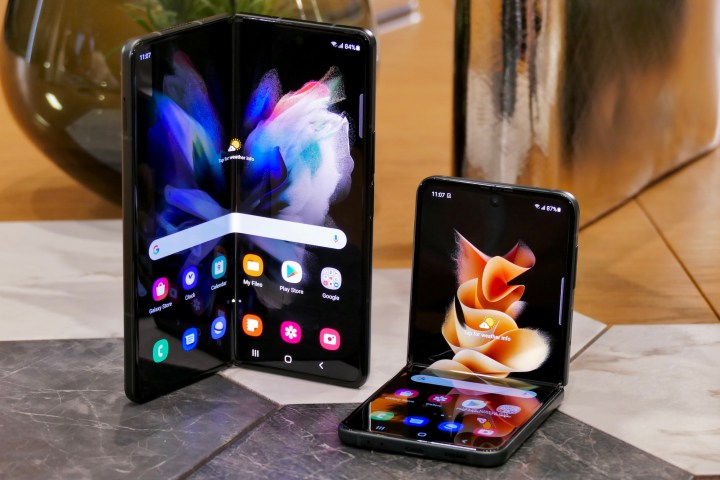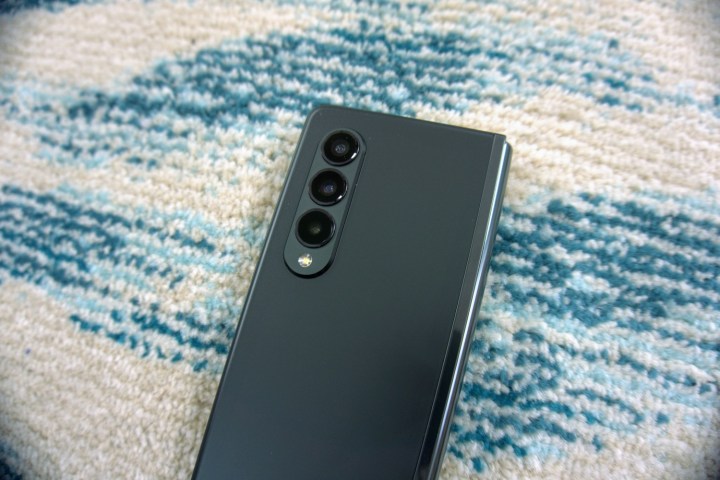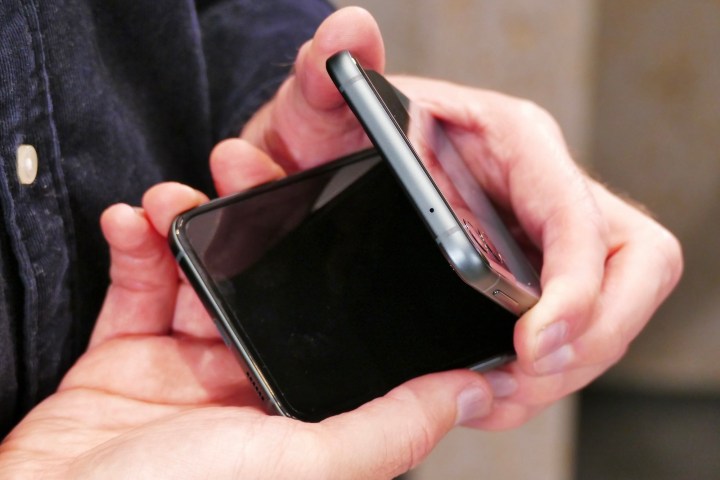There was a time when a bendy phone really wasn’t a good thing — Bendgate, anyone? But Samsung has changed the rules, and the two most impressive phones in the world right now are a pair with a big ol’ bend in the middle of their main displays. The Samsung Galaxy Z Fold 3 and Galaxy Z Flip 3 are here, and they’re rewriting the rules. If you want to sample the future, then Samsung’s latest phones are your best pick for a new phone. But of course, there being two means there’s a choice to make, so should you buy the Galaxy Z Fold 3 or the Galaxy Z Flip 3?
Thankfully, these two are very different phones in a lot of ways, and we’re going to explore both of them and their differences.
Specs
| Samsung Galaxy Z Fold 3 |
Samsung Galaxy Z Flip 3 |
|
| Size | Unfolded: 128.1 by 158.2 by 6.4mm (5.04 by 6.22 by 0.25 inches)
Folded: 67.1 by 158.2 by 16.0mm (2.64 by 6.22 by 0.63 inches) |
Unfolded: 166 by 72.2 by 6.9mm (6.5 by 2.8 by 0.27 inches)
Folded: 86.4 by 72.2 by 17.1mm (3.4 by 2.8 by 0.67 inches) |
| Weight | 271 grams (9.56 ounces) | 183 grams (6.5 ounces) |
| Screen size | Main: 7.6-inch Dynamic AMOLED 2X
Cover screen: 6.2-inch Super AMOLED 2X |
Main: 6.7-inch Dynamic AMOLED
Cover screen: 1.1-inch Super AMOLED |
| Screen resolution | Main: 2208 x 1768 pixels (374 pixels per inch)
Cover screen: 2268 x 832 pixels (387 ppi) |
Main: 2636 × 1080 pixels (425 ppi)
Cover screen: 300 x 112 pixels (303 ppi) |
| Operating system | Android 12 with One UI 4.1 | Android 12 with One UI 4.1 |
| Storage | 256GB, 512GB | 128GB, 256GB |
| MicroSD card slot | No | No |
| Tap-to-pay services | Google Pay, Samsung Pay | Google Pay, Samsung Pay |
| Processor | Qualcomm Snapdragon 888 | Qualcomm Snapdragon 888 |
| RAM | 12GB | 8GB |
| Camera | Rear main: 12-megapixel ultrawide, 12MP wide-angle, and 12MP telephoto rear
Front main screen: 4MP under-display Cover screen: 10MP |
Rear main: Dual-lens 12MP wide
Front: 10MP ultra-wide |
| Video | 4K at 60 frames per second, 1080p at 240 fps, 720p at 960 fps, HDR10+ | 4K at 60 fps, 1080p at 240 fps, 720p at 960 fps, HDR10+ |
| Bluetooth version | 5.1 | 5.1 |
| Ports | USB-C | USB-C |
| Fingerprint sensor | Yes, side-mounted | Yes, side-mounted |
| Water resistance | IPX8 | IPX8 |
| Battery | 4,400mAh
Fast charging (25W, charger not included) Fast wireless charging (10W) Reverse wireless charging (4.5W) |
3,300mAh
15W fast charging 10W fast wireless charging 4.5W reverse wireless charging (Wireless PowerShare) |
| App marketplace | Google Play Store | Google Play Store |
| Network support | All carriers | All carriers |
| Colors | Mirror Purple, Mirror Black | Cream, green, lavender, Phantom Black, white, pink, gray |
| Prices | $1,800 | $1,000 |
| Buy from | Samsung, AT&T, T-Mobile, Verizon, Amazon, Best Buy, Walmart | Samsung, AT&T, T-Mobile, Verizon, Amazon, Best Buy, Walmart |
| Review score | 4 out of 5 stars | 4 out of 5 stars |
Design, display, and durability
- 1. The Galaxy Z Fold 3 closed.
- 2. The Galaxy Z Fold 3 open.
- 3. The Galaxy Z Flip 3 closed.
- 4. The Galaxy Z Flip 3 open.
This is easily the most important category to go into for both of these phones, as the folding mechanism is probably the most exciting element for any buyer. While both phones share a lot of similarities, there are a lot of differences to be had, too.
The Fold 3 is the larger of the two devices by a large stretch, thanks to its book-like fold. Unfolded, it sports a 7.6-inch AMOLED display, running a 2208 x 1768 resolution with a 120Hz refresh rate. The size of it can’t be understated — it’s a tablet-sized display hidden within a phone. The cover screen is a 6.2-inch AMOLED 120Hz panel with a 2268 x 832 resolution. It’s narrower than a regular phone but still very clear, colorful, and everything you’d want from a phone screen.
The Flip 3 takes a different approach to the folding formula with a clamshell fold. The inner display is a 6.7-inch 2640 x 1080 AMOLED display with a 120Hz refresh rate. It’s not as wide as the Fold 3’s screen and is definitely a more regular phone screen (aside from the bending), but it’s clear, crisp, and colorful. The cover screen is much smaller, being more keyed toward notifications and basic information, like the weather. It sports a 260 x 512 resolution and measures just 1.9 inches.
Aside from the strong physical differences, the two devices are somewhat similar. Both have an IPX8 rating for water resistance, stronger Gorilla Glass Victus glass, and an improved hinge that’s even better at keeping out the small particles that spelled disaster for the first Galaxy Fold.
So on paper, the Fold 3’s larger screens and bigger specs mean it wins, right? Well, not really. While the Fold 3’s tablet-like display is excellent and very useful once you get used to it, it means the phone is as thick as two phones when folded. That’s technically also an issue for the Flip 3, except the Flip 3 comes with a smaller folded footprint, which will attract those who don’t want as large a phone in their pocket. The phone’s ability to shrink down and transform into a more regular size is as strong a selling point as the Fold 3’s massive display, and we think the two are at loggerheads. Picking between the two styles is going to be a personal preference, as it’s largely a choice between style and performance.
Winner: Tie
Performance, battery life, and charging

These two foldable phones are flagships through and through, and that means strong flagship specs. Both have a Qualcomm Snapdragon 888 processor, which is going to be enough to keep the phone humming away happily and playing top-tier games for a long time to come. The Fold 3 does have an advantage with 12GB of RAM, and the option between 256GB or 512GB of internal storage. The Flip 3 comes with 8GB of RAM and either 128GB or 256GB of internal storage, giving the larger device a small edge. Still, it’s relatively slight.
As you might expect, the larger device also comes with a much larger battery. The Fold 3 has a 4,400mAh dual battery, while the Flip 3 has a smaller 3,300mAh dual battery inside. These are two relatively small batteries for the size of phones we’re dealing with, and so battery life isn’t as long-lived as we’d have liked. The Flip 3 holds up slightly better than the Fold 3, which generally needed an evening top-up to get through the day. Still, neither is a powerhouse in this regard, and it’s disappointing.
Both phones support 25W fast charging, 10W wireless charging, and 4.5W reverse wireless charging — though it’s important to note neither comes with a charger, so you’ll need to buy your own, unfortunately.
We’d previously awarded this to the Galaxy Fold 3 for the stronger specs — but due to the disappointing battery performance, we’re changing it to a tie.
Winner: Tie
Camera

The Flip 3 has the more conservative camera setup of the two phones. It has a 10MP selfie camera and a pair of 12MP lenses on the rear, one of which is a wide-angle lens. There’s no telephoto lens, and the megapixel count is a little lower than you might expect for a 2021 flagship, but for 2021, this is an acceptable setup for a camera suite. It isn’t going to end up on our best camera phones list, but it’s still a good camera setup.
The Fold 3 has a much larger suite of cameras. The back has a triple-lens setup with a 12MP ultrawide lens, 12MP wide-angle, and 12MP telephoto lens. The cover has a 10MP selfie lens as well, and as if that wasn’t enough, there’s another selfie lens hidden in the large display, too. Yes, in the display. There’s a 4MP “under-display camera” (UDC) underneath the main display, and while the technology is an interesting idea, it’s definitely not up to the standard of the other camera lenses. Frankly, it just isn’t good enough in this day and age, and using the cover’s 10MP selfie lens or even the main rear camera setup (and the cover display as a viewfinder) is recommended.
Still, even with this misstep, the Fold 3’s camera suite is the more versatile of the two on offer, though both take good pictures in practice.
Winner: Samsung Galaxy Z Fold 3
Software and updates

There’s not a huge amount to say here, as both phones ran similar versions of OneUI 3 (over Android 11), keyed to their particular shapes, and both have received the Android 12 update as well. As such, you’re going to get a similar software experience on both — and it is good software, too. OneUI has come a long way since the bad old days of TouchWiz, and it’s no longer a chore to find Samsung-branded software on your device.
Updates are likely to be a tad slower than you’re used to if you’re coming from a Google Pixel or an iPhone. Still, Samsung has sped up its updates in the past couple of years, so you shouldn’t be left behind by other brands too much. You can expect to get similar update times on both of these though, so this is a tie.
Winner: Tie
Special features

You might have expected Samsung to call it a day and just say, “Hey, the phones fold, that’s special enough,” but it hasn’t. Both phones have a 5G connection, a special feature that’s rapidly becoming less and less special as time moves on. The Flip 3 makes the most of its compact folding shape with the Flex Mode, giving you hands-free photos and video streaming quickly and easily, but it’s the Fold 3 that really shines where special features are concerned.
The large inside screen means it’s excellent for multitasking, and you can open up to three apps at the same time. Add support for the S Pen to this (but only special, Z Fold 3-supported S Pens are allowed), and you’ve got a big, handy phone that’s versatile and powerful in equal measure. It wins this round.
Winner: Samsung Galaxy Z Fold 3
Price and availability

Here’s the big one — how much will the future cost you? The Galaxy Z Fold 3 is the more expensive of the two, by a large amount. The basic model, with 256GB of storage, starts at $1,800. However, doubling storage will only cost an extra $100.
The Galaxy Z Flip 3’s price is significantly lower. With prices starting at $1,000, it’s not an unreasonable prospect for someone looking to pick up a current-generation flagship. As such, it’s a great choice even if you’re not usually on the bleeding edge of new technology.
Overall winner: Samsung Galaxy Z Fold 3
While the Samsung Galaxy Z Flip 3 will have its fans due to its smaller size and clamshell flip, the Galaxy Z Fold 3 is pretty clearly the stronger of the two devices where pure specs are concerned. It has more RAM, more multitasking capabilities, and a much larger tablet-sized screen. It’s the more powerful of the two, and it’s clear you get a lot for your money.
But does that mean you should just always buy the Fold 3? Well, not for sure. While it’s clearly the more capable of the two devices, the Flip 3 is still a very powerful device, and the clamshell fold will be attractive to anyone who doesn’t like the feel of a huge device in their pocket — and the Fold 3 very much is a large device. So if a smaller footprint is important, buy the Flip 3. If not, and productivity and usefulness are at the top of your list, well, you can’t go wrong with the Fold 3.
Editors' Recommendations
- The best Samsung Galaxy Z Fold 4 deals
- Samsung has a new (and cheaper) way to buy the Galaxy S23
- Samsung Galaxy Ring: news, rumored price, release date, and more
- Best phone deals: Save on the iPhone, Galaxy Z Fold 5, and more
- The 20 best Samsung Galaxy Watch faces you should be using





